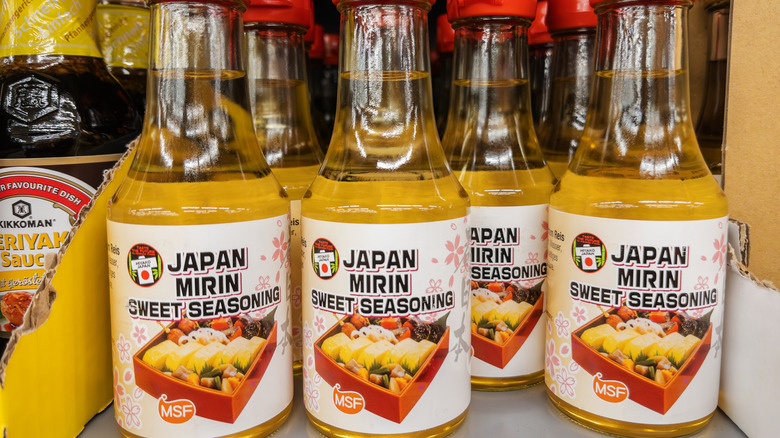Bring Loads Of Umami To Fried Rice With One Liquid Addition
Fried rice is arguably the ultimate way to transform plain, bland rice into an all-star dish. When it's done right, it's hot with tender rice (with the perfect amount of crispy rice grains), and enhanced with scrambled eggs, fork-tender vegetables, and just the right amount of salt from soy sauce. It's great as your main course or as a side dish. But there is one overlooked liquid ingredient that can make your fried rice truly perfect and unforgettable, according to Maricel Gentile, chef and owner of Maricel's Kitchen, and author of "Maricel's Simply Asian Cookbook." She believes mirin will forever change how you make the dish.
Gentile told us, "Mirin gives a gentle sweetness and sheen that balances salt and spice. It rounds the edges of flavor, bringing harmony to the dish." When she makes the dish at home, Gentile adds about 1 tablespoon to the rice, just before it finishes cooking. She explained, "Mirin comes after salt but before soy sauce as it ... coats each grain and helps caramelize the bits that touch the pan, giving the fried rice its beautiful shine and balanced flavor." It's the addition of this special ingredient that can bring out maximum umami in the dish, and make your fried rice taste like it came from a restaurant.
Mirin and its substitutes
If you've ever made your own sushi rice, chances are you've worked with mirin, which is a Japanese cooking wine that is often mixed into cooked sushi rice, along with some vinegar and sugar to give it its signature flavor. It does contain alcohol, but that mellows when heated and used in cooking. Mirin is made by fermenting short grain, glutinous rice (which is different from long grain rice) with koji (grains or soybeans inoculated with mold) in shochu (distilled alcohol) for anywhere from a couple of months to three years. As the rice starches break down and ferment, sugar and amino acids are created, which is what results in the sweet-savory flavor of mirin.
It not only enhances fried rice, but does the same for Japanese noodles, stir-fries, dressings, and sauces; it's a key ingredient in teriyaki and ponzu sauce. While it's sometimes mistaken for sake, it is a completely different liquid product. Although, if you don't have mirin on hand, you can make a substitute out of sake. Just combine three parts sake with one part sugar and you can use this as a mirin replacement. Sweet marsala wine and dry sherry also work well in a pinch. If you can't find mirin in your grocery store, try looking for it at an Asian market.

